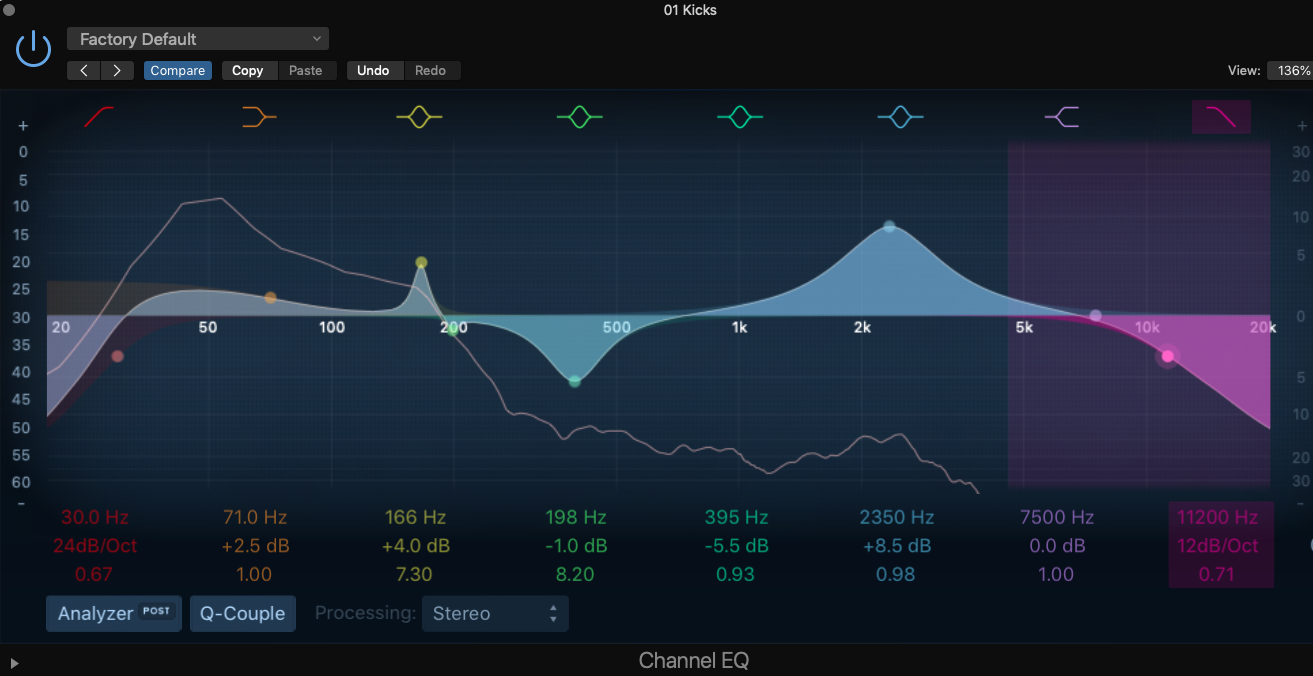5 steps to craft the perfect bass drum
Kick, Bass Drum, BD… all perfectly acceptable names for the thudding sound drummers trigger with their feet. In electronic music this is often simulated by a sampler or drum machine, and can vary wildly in tone, style and dynamic range.
These thudding sounds are beyond important to Dance and Electronic music. In many ways, they are the music. Take the kick out of any given track and it falls apart immediately. The kick drum is the glue that holds a track together. The low, thudding rhythmic quality is what we instinctively dance to in the club.
Needless to say, making sure your kicks sound great in your tracks is vital.

Kick It
It may seem simple at first glance – the rhythm is usually fairly consistent, and there are literally tens of thousands of bass drum samples available in sample packs across the web.
But it’s exactly that overload of choice that creates problems for a lot of producers.
How do you:
Decide which BD sample to use?
Know what is going to sound best in your track?
Make your kick stand out from the crowd?
Know if it’s a good match for your track?
Decide what kind of kick drum you want?
Write Chords Faster with Captain Chords
- Use Captain Plugins to write your own Chord Progressions, Hooks, Melodies and Basslines
- Export to your DAW
- Available on Mac and Windows.
1. Choose Wisely
Generally speaking, bass drums come from one of three sources:
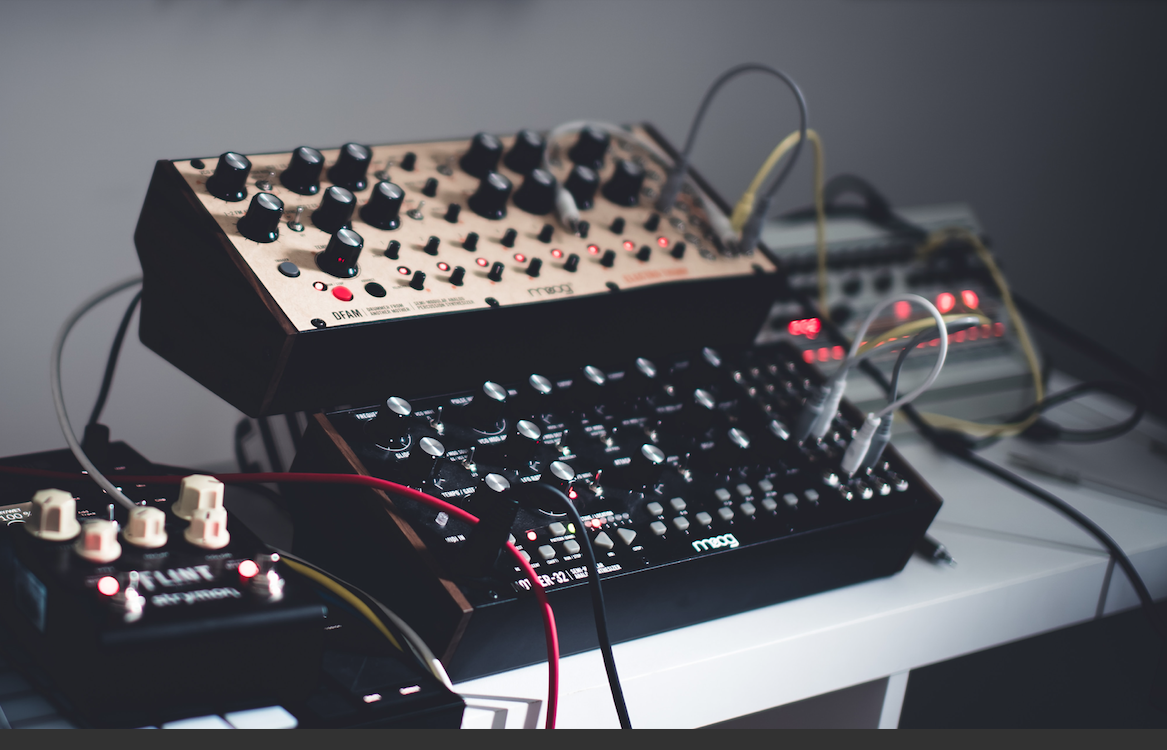
Synthetic
Since a kick is mostly just a short bass tone, it’s entirely possible to create one using a synthesizer. Indeed, when we talk about drum machines, we are ultimately describing synthesizers programmed to create percussive sounds instead of melodic sounds.
Synthesized kicks have been used in electronic music since the first drum machines were invented in the 1960s, and have spawned entire genres of music, almost single-handedly.
A tale of two cities
Two particularly clear examples of this are the House music of the 1990s. Just a few miles apart, the cities of Chicago and Detroit were shaping the sound of music to come.
Detroit was famed for its grittier take on House music, that came to be called Techno, while Chicago held closer to its Disco roots and is credited with being the birthplace of House music as we know it.
Detroit’s DJs were using a Roland TR-808 for the drums in their tracks, while Chicago’s DJs favored the Roland TR-909. Two legendary drum machines, two seminal sounds that are still being used in all kinds of music today. These drum machines had recognizably different kick sounds, and serve to show how a different sounding drum pallette can dramatically color your tracks.
Synthesized drums usually sound very different to acoustic drums, and generally have more body and more punch, which is why they are often favored in electronic music!
If you have a synthesizer yourself, you can create your own kick drums by playing a short, low bass sound with a sharp Attack, high Sustain and fast Decay setting. It’s a great way to ensure your kick is unique, which in turn helps your music stand out.
Equally, there are thousands of synthesized kick drums in sample packs across the internet, from faithful replicas of classic kits to modern digital creations.
This synthesized kick can be the finished product for your track, or it can be the basis for a composite kick. What’s a composite kick? Keep reading, we’ll come to that…
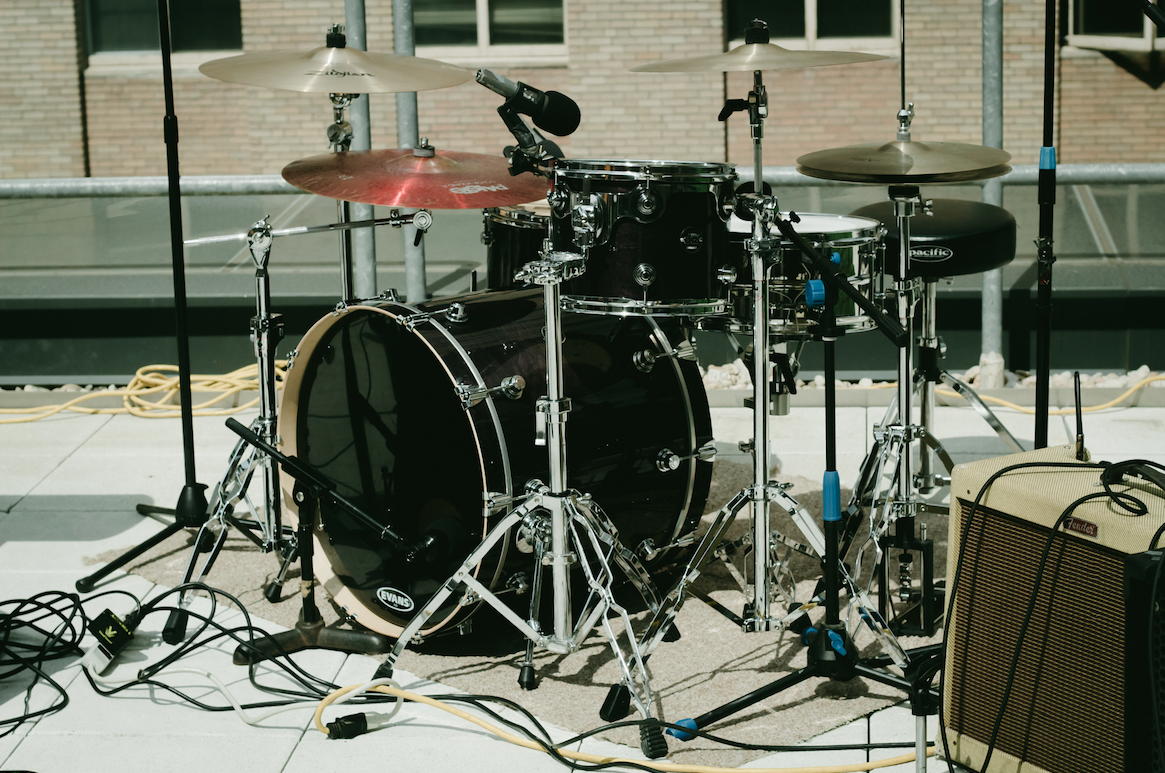
Acoustic
Played by a real drummer on a real drum kit, acoustic kicks have a very different sound – the human performance aspect and the traditional sound source (a drum skin and a beater) make these sounds well-suited for expressive music like Hip-Hop, Soul, Jazz, Latin and more organic styles of other genres.
But you don’t need a real drummer with a kit to use these sounds in your music. There are thousands of samples available, plus software such as Native Instruments’ Kontakt which can emulate acoustic drums digitally.
These drums are often used in harder, more club-focused music, too. Usually this is as a secondary kick, which is a neat trick for adding additional groove to your bass drums without allowing the kicks to dominate. Two large, full-bodied kick sounds competing against each other can be overpowering and leave no room for bass. Another way acoustic kick sounds are used in electronic music is as part of a composite kick…
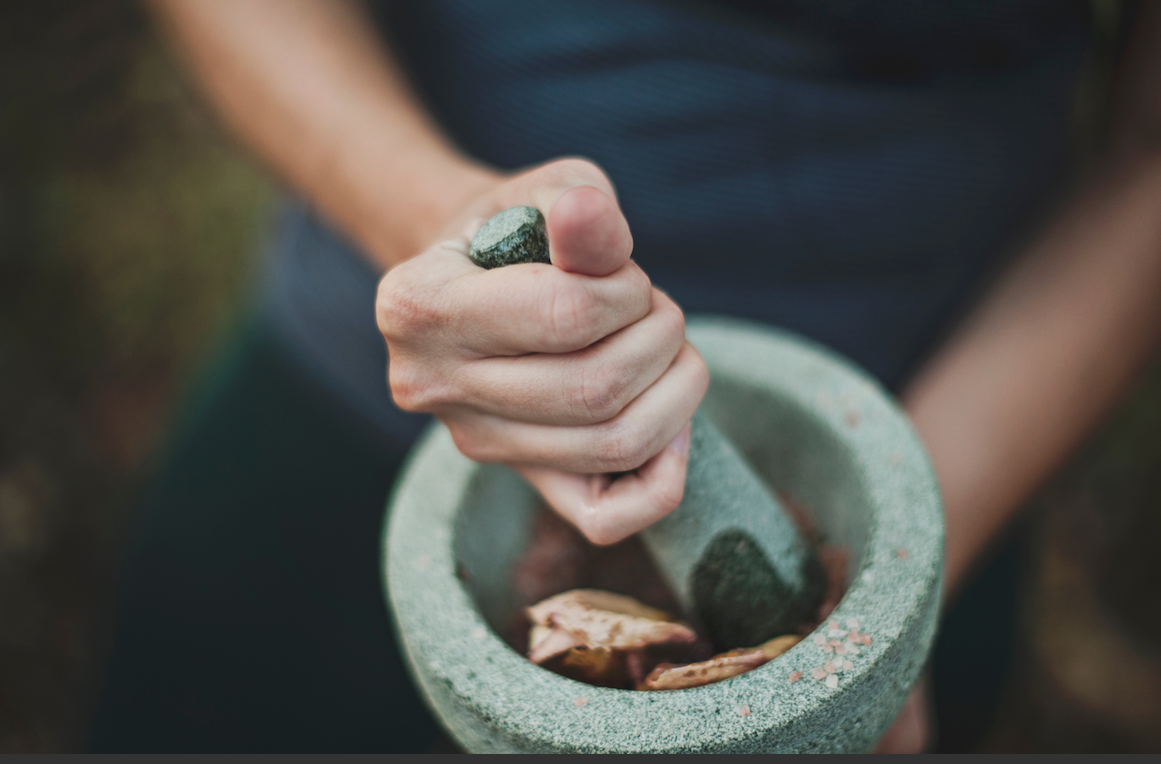
Composite
The secret weapon of many top producers is the composite kick. Also known as a Layered Kick, it’s a way to craft the perfect bass drum for your track and ensure it has the full range of dynamics, texture and frequencies that you need.
Admittedly, knowing exactly what it is you need is something you pick up with experience. There’s no fast-track for learning the intricacies of sound behavior and performance aside from practice.
The sum is greater than the parts
And the actual process of creating a composite kick is fraught with danger – it’s very easy to make a mess. Think of composite kicks like a soufflé… when executed to perfection it’s delicious, finessed and highly impressive. But it’s much easier to fail and create a floppy, lifeless bowl of sugary eggs!
As such, many rookie producers opt to stick with sampled kicks, which are often composite kicks crafted by experienced professionals.
That said, we recommend learning the techniques required to create a great composite kick. They can be applied to many other aspects of your work and will make you a better producer overall. Understanding frequency ranges, EQ and how to stack sounds together is a skillset you won’t regret learning!
In the context of kick sounds, you can take the dynamic, satisfying top end of an acoustic kick drum and marry it to the beefy bottom end of a synthetic bass drum. With a little craft, you’ll have a unique, powerful kick that suits your track perfectly.
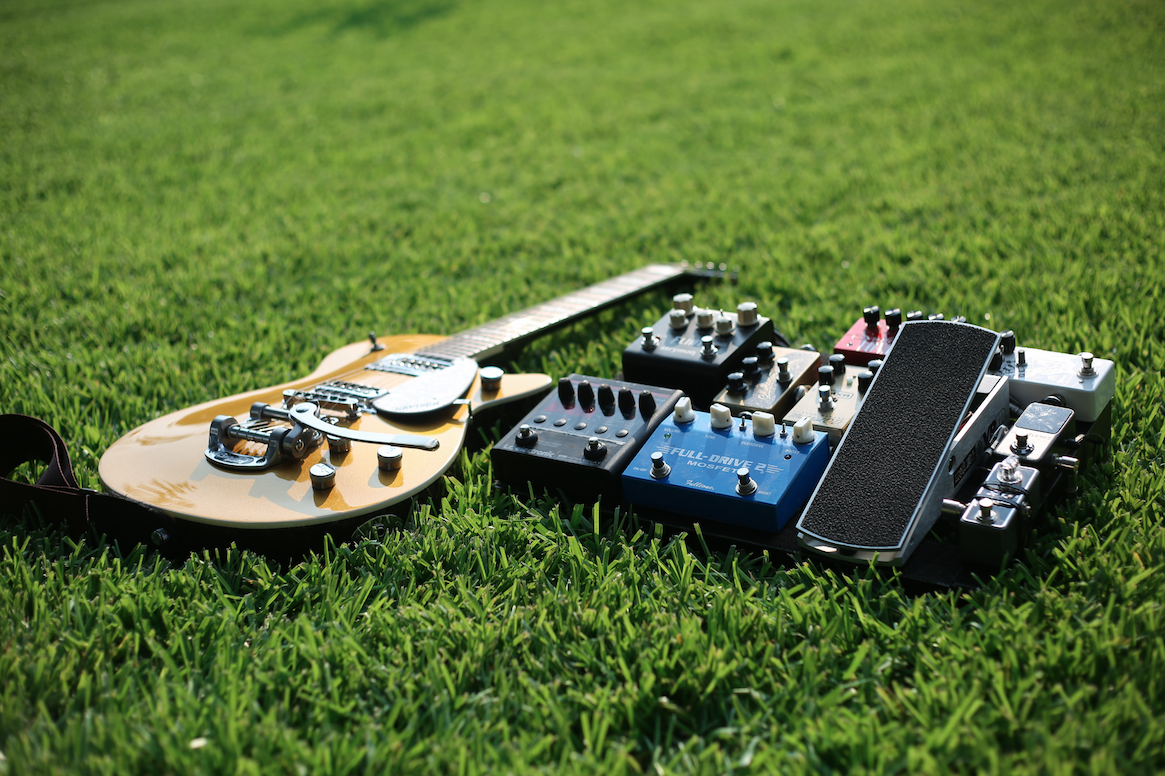
2. Tune Up
One of the tell-tale mistakes that rookie producers make is not tuning their drums. Out of tune drums clash with the music and give the listener an unsatisfying experience.
Bass drums are essentially just low tones, and as such need to be in tune with the key of your track. Some kicks are comprised entirely of such low frequencies (below 80Hz or so) that the human ear can’t really pitch it – and thus they don’t need to be tuned. However, most kicks are made up of two parts – the thud (low end) and the snap (top end). If the snap end is out of tune with your track, it sounds bad.
Enter Mixed In Key Studio Edition.
With our brand new plugin for producers, you can now determine the exact pitch of a sample in real-time, inside your DAW. You can also use it to determine the overall key of your track, which makes finding the right samples child’s play.

3. Shape and Tone
Once you’ve decided upon a sound (or sounds), and tuned it to match your track, you’re ready to start sculpting the shape.
This is often a case of trial and error, but as a general rule it’s a good idea to try and have the kick fade out at a rhythmically pleasing moment e.g a full quarter note. It’s usually a good idea to match the kick to the bass too, so ensure the attack is set so the bass and kick strike at the same moment whenever they cross paths.
The exact methodology of shaping your sound will vary depending on your tools. Different DAWs and different amplers, synths and drum machines will have different workflow.
However the overall goal is always to be in tune and with a punchy, rhythmically satisfying bass drum sound. It’s also a good idea to pay attention to the relationship between the Decay and the Sustain of your sound.
How long does it stay at its loudest point, and how long does the decay take to fade to zero? These are fundamental considerations regarding the overall aesthetic of your bass drum sound.

Push the Envelope
Whether crafting a composite kick, or using a simple sample or synthesized sound, you’ll need to decide on the characteristics of your kick. It’s no exaggeration to say they can vary wildly! Let’s take a look at some of the more common variables:
Attack
This is the speed at which the drum reaches full velocity. The sharper the attack, the more punchy the sound. Most bass drums have a fast attack, but some are slower which gives them a woozy, wooly aesthetic that can suit some tracks.
Decay
The speed at which a sound fades to silent is important in most contexts. With kicks, it’s known as the ‘tail’. A short tail is most common. This is because the kick usually takes up most of the real estate in a mix.
When it’s at full volume, it dominates and leaves little room for other frequencies. This is why Side-chaining kicks to the bass is such a common technique.
A drum with a short tail will quickly open up more space in the track for other instruments, which is usually desirable. However, there are many examples of this ruke being broken. Think of Julio Bashmore’s club classic ‘Battle for Middle You’.
In this, he uses long 808 bass drum sounds and pitches them to form the entire bassline. This follows a long tradition in hip-hop of using long bass drum sounds as fat, subby basslines.
It works great when your other bass source is thinner, such as a sampled bass guitar. Thus, long bass drums work brilliantly in sample-heavy Hip-Hop.
Sustain
How long the drum plays through at maximum volume
Bend
Some kick drums have a little (or a lot of) bend between the start and end pitches. This gives a sort of ‘peow-peow’ sound, like a laser gun firing. This can give kicks extra zip and is a technique often used in hard dance music styles like Psy-Trance.
It doesn’t suit every style but it’s worth looking out for as it can give quite an unusual vibe to your track!
Click
This is the loudness of the top end of your sound. It can have a characteristic ‘click’ sound or can be more of a tap. Either way, this is often the sound that cuts through the mix better than the bass end, so choosing a sound with the right tone and character is very important.
You’ll know what that is by trial and error, in many cases.
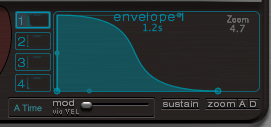
Logic’s Ultrabeat displays the drum envelope like this

while Ableton’s Drum Rack shows it like this
PRO TIP
Set up a software sampler, like Ableton’s Drum Rack.
Loop a kick drum pattern in your project, run the whole track (or as far as you’ve got) with the kick loop, and try replacing the kick sound with other options as it plays through.
If it sounds good amongst the sounds of your track, it bodes well for a good overall match!
PRO TIP
Keep your kick drum mono.
You want your kick drum as central as possibe in the mix, so there’s no need for it to be in stereo. You can still add widening to your mono bass drum if you wish, but keeping it mono reduces the risk of unwanted phasing and mud in the low end.
EQ
EQ has a profound effect on a kick drum’s character
Another way of shaping the sound is to adapt the frequencies to suit your needs using EQ. The application of EQ in music could be, and is, the subject of an entire book, but in a kick drum context there are a couple of general rules to consider.
In almost all cases, you want it to be heavy in the sub and bass end.
Let’s take a look at a few settings that might help acentuate te right bits of your bass drum
Sub is generally around 60Hz, and bass at the 150-180Hz region.
Sub
Try boosting with a low shelf at around the 70Hz mark down to around 30Hz, at which point add a Low Cut to roll off frequencies below 30Hz. These frequencies are imperceptible to the human ear but will potentially add muddiness to the mix.
The exact point at which to roll off the sub with your Low Cut (AKA Hi-Pass Filter) is debatable. Many dance music producers say 30Hz, but if your main source of sub bass comes from bass synths, you could raise the mark to 50Hz. Pendulum famously use a 50Hz Hi-Pass to allow their monstrously subby bass synth-work to roam through the mix unchallenged.
Bass
To accentuate the thudding part of your kick, you could also add a relatively sharp notch in your EQ at around the 150-180Hz point.
Mid-range
Next, you may want to consider dipping the frequencies around the 350-500Hz mark. This won’t always sound right, and it depends on your overall mix and bass sound. However in many cases it can provide a little more room for other instruments without reducing the impact of the bass drum.
Click
Finally, you may want to try boosting the ‘click’ frequencies to give the sound extra pop. These frequencies can be anywhere from 15KHz to 20KHz – nit’s entirely dependent on the drum’s characteristics.
Let’s hear it for your ears

As with all music production processes, the main thing is to listen and go with what sounds best to you. Using a spectral analyzer is a handy way of visualizing these frequencies, which is something the stock EQs of Ableton, Logic and many other DAWs provide.
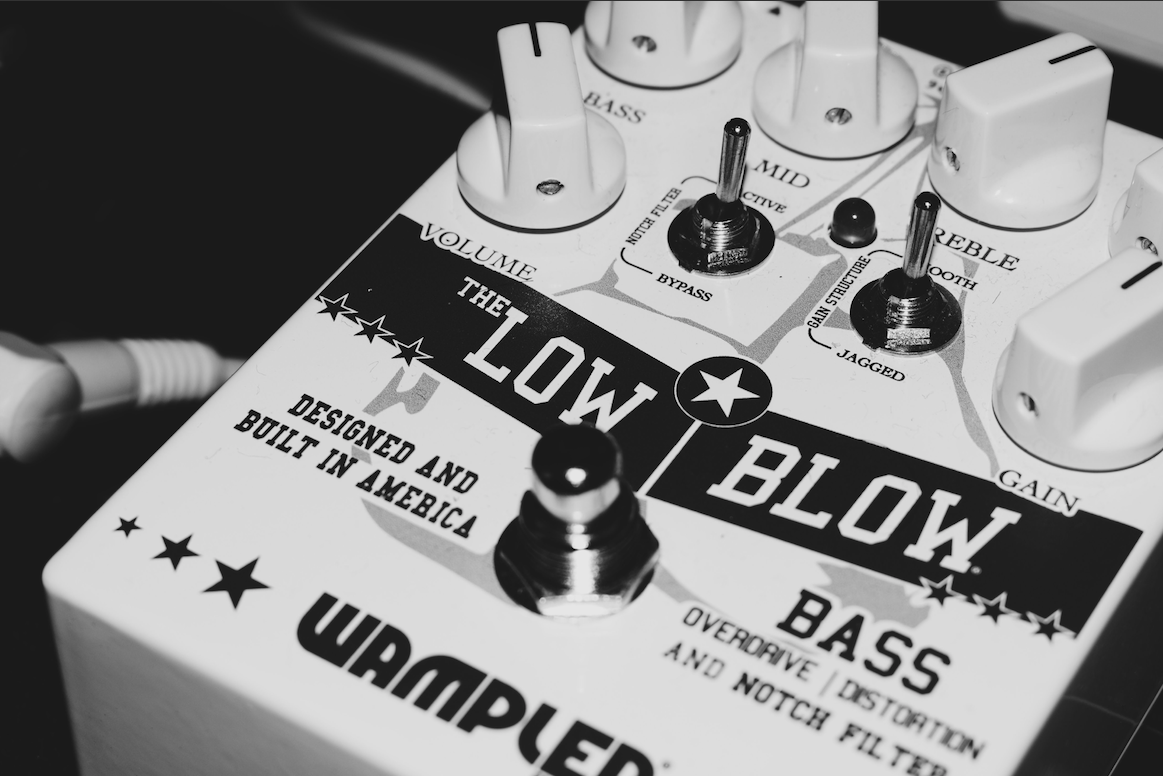
4. Saturation
Listen to how saturation, such as from Izotope Ozone 8’s Vintage Tape plugin, can add warmth and body. In this example we are also hearing a bass synth side-chained to the composite kick drum so it stands out more
Now we have a perfectly shaped bass drum sound, which is fat in all the right places, and has a character that’s perfect for the track. Awesome! Let’s move to the finishing stage.
This is where Saturation and Compression can take it to the next level.
Saturation, AKA Distortion, can be provided by any number of plugins, from Tube Amp emulations to Pedal-boards, Fuzz Boxes and even Bit-Crushers. Most DAWs come with an array of saturators as standard, which effectively color the sound by distressing it.
You may ultimately want a totally clean, pristine kick drum sound. However, in most cases even in the crispest of production styles a little saturation adds warmth and body.

5. Compression
Compression is fundamental in helping a bass drum cut through the mix
Compress for success, as the saying goes! It’s another book-length topic, but for kick drums we can condense this to a few general pointers…
The basic principle is to tell the compressor to align the volumes of the loudest and quietest parts of the track so there isn’t too much dynamic range, You want a little, but too much and you lose the punching power of the bass drum which is so important for most music.
While compressors can vary wildly, here are some guideline settings to try out. You can always tweak them to suit later.
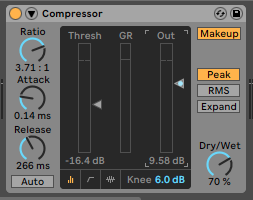
As you can see in the above image, which is purely a general guide, we have some specific settings for kick drums.
Ratio
A ratio of approximately 4:1 is pretty standard for kick drums. The higher the ratio, the more impact the compressor has.
Attack
Set to attack fairly sharply, but slowly enough to allow a bit of uncompressed sound in before the compressor bites, this clamps down on the sound.
Release
Make sure it’s slightly higher in value than the Attack. This ensures the comressor reaches maximum before it is released. If the release is too fast it can cause a strange bobbling soun d in the tail of the kick, so be careful to ensure it isn’t too short. It shouldn’t be so long that it hasn’t fully released before the next kick sound either.
Threshold
A very important setting. This determines the minimum volume at which the sound is compressed. The lower this value, the more aggressively the compressor bites.
Makeup
This is sometimes called Gain, and effectively allows you to take a compressed signal and add volume so it retains it’s pre-compression volume, but with all the bonuses that compressio brings.
Dry/Wet
You can allow a little ‘naked’ signal into the output. This can act as a very basic kind of parallel compression, and can allow the sound to retain it’s original dynamics.
Sidechain
The next important tool to employ is the sidechain function of yur compressor. Not all compressors have this, so it’s generally advisable to find one which does for kick drum sounds.
This process tells your trigger sound – the kick drum – to make the compressor on the sound you want to affect – usually the bass – to get out of the way when the kick drum sounds.
It’s a great way of clearing space in the mix for two sounds which occupy a similar frequency band, such as bass drums and bass synths.
Different DAWs have different methodology to achieve this, as do different compressors. Ultimately the principle if to set the compressor that will be affected to the Bass channel, and tell it to ‘listen’ for the trigger sound (the kick). This is usually done by assigning it to the appropriate channel or bus.
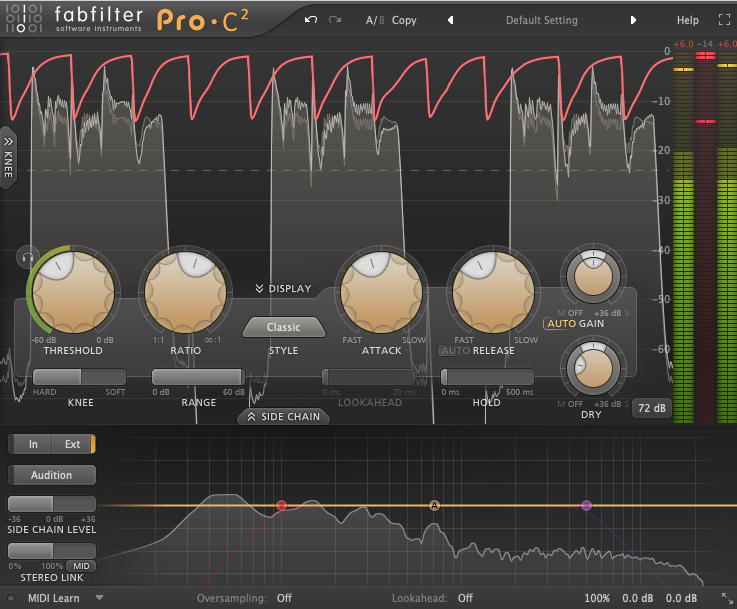
PRO TIP
Don’t be afraid to use a separate compressor in addition to the sidechain compressor to compress the sound when the kick isn’t triggering the sidechain
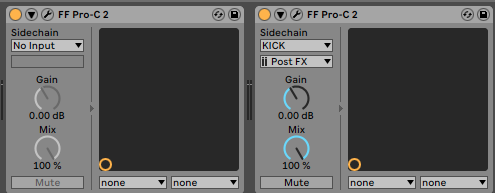
PRO TIP
You don’t have to only sidechain Kick and Bass together. For a dramatic effect, try creating a bus for all your sounds except the kick, and setting a sidechain compressor on that group, triggered by the kick.
With a sharp setting, you’ll hear the kick literally cleave space in the mix so it’s the dominant sound when it strikes. This gives you an idea of the power of this technique.
Additional Compression
Lots of producers find that they have got their bass drum sounding just right, but it still down’t carry through the mix with enough power, even after sidechain compression.
You can keep cranking the compression but in the end it will just start sounding bad – over-squashed, digitally clipped and unpleasant. There are a couple of things you can try to bring your kick out further in the mix.
Parallel Compression
Parallel compression is one of the most effective tricks of professional dance music producers!
This is a great technique for adding bite… send your kick or kicks to one dedicated Send Channel. Then, add a new compressor to that channel – and make it super intense!
It will squash the life out of the drum, and render it just a hard, nasty popping/thudding sound. Which should be a bad thing, however, the principle here is to diminish the send channel’s volume so much that it only flavors the overall sound with a bit of artificial punch. The listener can’t hear how it would sound without the rest of the mix, and just hears an extra punchy kick drum.
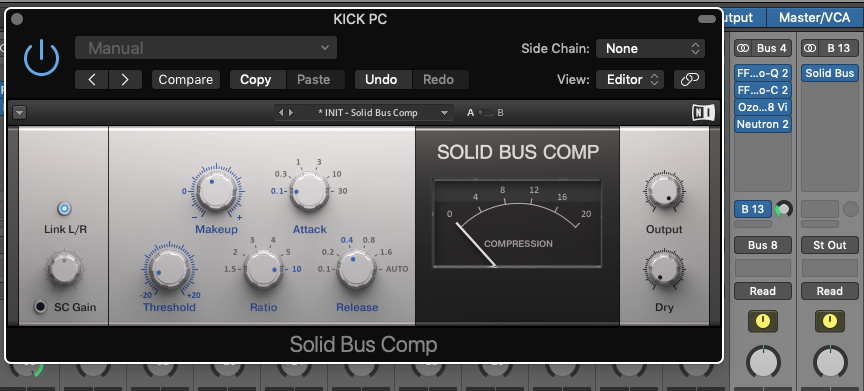
Bus Compression
Bus compression can be used in many different ways – usually on the main Master Bus or a Drum Bus to ‘glue’ sounds together. It can also be applied to a Kick Drum Bus, where it can add pop to the sound. Beware, though – too much and you’ll squash the life out of the sound.
Compression is a powerful tool which we have lightly touched upon here… it can be the difference between a good and a great mix, but it can also ruin a mix. As with all these processes, the golden rule is to use your ears and make sure it sounds good to you. Don’t forget to use A/B tests to ensure that the process you just added really does improve the sound overall.

Kick up
Hopefully these 5 steps will help you source, shape and process the perfect kick for your tracks. If ylu can master the principles behind these techniques, you’ll be making great kick drums, and you can apply these theories to many more sonic applications, too!
Final thoughts
Mono Vs Stereo
Mix your Kick drum on a Mono channel, not stereo. Your bass drum will predominantly want to cut directly through the center of your mix, so keeping it mono avoids the risk of phasing
Reverb
We’ll reserve the last word to address a common question; should you add reverb to the kick drum? In a word, no!
There are circumstances where some reverb can be effective, and there are producers who are expert enough to make it work. But, as a general rule it’s unadvisable. It will add wooliness and extend the tail of your sound, which as we’ve just detailed, should be precisely tailored.
So don’t undo all your hard work by adding a flappy reverb to your kick drum!
Write your own tracks using Captain Plugins
It’s super easy to create your own ideas from scratch. Visit the official Chords Plugins homepage and see how it will help you explore music and write your own original productions.

